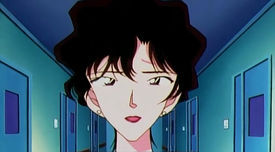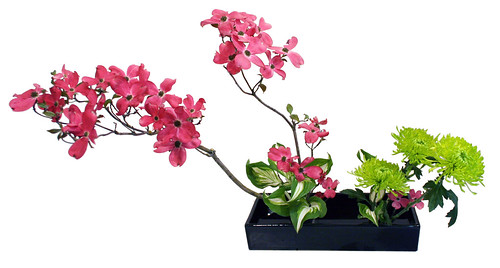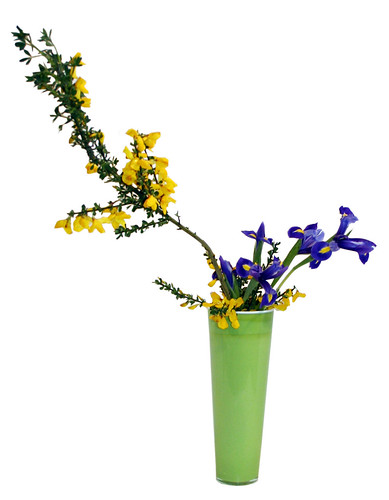
Pronunciation:
‘め’ is romanized ‘me’ and prononced ‘me’ as in ‘met’.
Words with ‘め’:
‘め’ at the beginning:
- めがね (megane -> glassess)
- 回る / めぐる (meguru -> spin; rotate; round)
- 迷惑 / めいわく (meiwaku -> nuisance; trouble; annoyance)
- 目 / め (me -> eye)
- 目指す / めざす (mezasu -> aim)
‘め’ in the middle:
- 運命 / うんめい (unmei -> fate; destiny)
- 冷たい / つめたい (tsumetai -> cold [things])
- 場面 / ばめん (bamen -> scene; setting)
- ごめん (gomen -> sorry)
- 有名 / ゆうめい (yuumei -> famous; popular; well-known)
‘め’ at the end:
- だめ (dame -> don’t)
- ため (tame -> for)
- 雨 / あめ (ame -> rain)
- 姫 / ひめ (hime -> princess)
- 夢 / ゆめ (yume -> dream)
Stroke order:


Task: You shall write ‘め’ 50 - 100 times in your textbook. Memorize the shape, the stroke order, the sound, the pronunciation (echo the sound of the character each time you write it down), etc.
And after you are finished with that, write ‘ま’, ‘み’ ‘む’ and ‘め’ one after each repetitively (ま, み, む, め, ま, み, む, め, etc.) 50 times (100 if you have time).
Ikebana
Megure: *cough* *cough* Konnichiwa (Hello!), today, kono (this) Juuzo Megure is in charged of assisting today's lesson!
Megure: And the topic still about Japanese culture. Well, I'm not going to tell you about Japanese Police right now, but maybe later. Midori?
Midori: Doushita no, Anata? (What's the matter, Dear?)
Megure: You're ready to start off the lesson?
Midori: Oh, hai~ Konnichiwa, minna! Today, we're going to know closer about one of Japanese culture, which is Ikebana!
Midori: Ikebana is from the Japanese ikeru (生ける, "to place, to arrange, life, birth") and hana (花, "flower"). So, ikebana is Japanese art of flower arrangement.
Megure: More than simply putting flowers in a container, ikebana is a disciplined art form in which nature and humanity are brought together. Contrary to the idea of floral arrangement as a collection of particolored or multicolored arrangement of blooms, ikebana often emphasizes other areas of the plant, such as its stems and leaves, and draws emphasis toward shape, line, form...
Midori: Anata, why do you know much about ikebana?
Megure: Ahaha~ jitsu wa (actually), I once read your ikebana course book...
Midori: What for?
Megure: Ano... maybe someday I'll give you my own flower arrangement- Hahaha~
Midori: I don't know since when you became a romantic. Maa (well), back to lesson. Another aspect of ikebana is minimalism. That is, an arrangement may consist of only a minimal number of blooms interspersed among stalks and leaves. The structure of a Japanese flower arrangement is based on a scalened triangled delineated by three main points, usually twigs, considered in some schools to symbolize heaven, earth, and man and in others sun, moon, and earth. The container is a key element of the composition, and various styles of pottery may be used in their construction...
Midori: Ssst... there's also a spiritual aspect of it! SILENCE is a must during practices of ikebana. It is a time to appreciate things in nature that people often overlook because of their busy lives. Ikebana can inspire one to identify with beauty in all art forms. This is also the time when one feels closeness to nature which provides relaxation for the mind, body, and soul.
Megure: Talking about ikebana, you haven't told us about the history about it...
Midori: Oh, you're right~ well, it began in the sixth century when Buddhism was introduced to Japan. The offering of flowers on the altar in honor of Buddha was part of worship. Ikebana evolved from the Buddhist ritual of offering flowers to the spirits of the dead...
Megure: Then, when the first classical styles of Ikebana started?
Midori: In the middle of fifteenth century. The first teachers and students of Ikebana were Buddhist priests and members. The oldest school of ikebana named Ikenobo. The school dates its beginnings from a priest of the Rokkakudō Temple (六角堂) in Kyoto who was so skilled in flower arrangement that other priests sought him out for instruction.
Megure: How about the evolution of styles?
Midori: Ikebana in the beginning is very simple, constructed only a very few stems of flowers and evergreen branches. This first form of ikebana is called Kuge (供華).
Midori: Shooka style consists of only three main branches, known as ten (heaven), 'chi' (earth), and 'jin' (human). It is a simple style that is designed to show the beauty and uniqueness of the plant itself.
Midori: Jiyuuka is a free creative design. It is not confined to flowers; every material can be used...
Megure: Hmm... actually I don't really get the differences between those four, but yeah... maybe women know more... then in this modern era, is the style still the same?
Midori: In the 20th century, with the advent of modernism, the three schools of ikebana partially gave way to what is commonly known in Japan as Free Style. Those styles are Moribana Upright Style which is considered as the most basic structure in ikebana. Moribana literally means “piled-up flowers” that are arranged in a shallow vase or suiban, compote, or basket. Moribana is secured on kenzan or needlepoint holders, also known as metal frogs...
Midori: Moribana Slanting Style is the reversed arranging style that can be used depending on the placement of the display or shapes of the branches. Branches that look beautiful when slanted are mostly chosen for this arrangement. This style gives a softer impression than the upright style...
Midori: Nageire Upright Style is arranged in a narrow-mouthed, tall container without using kenzan or needlepoint holders. Nageire literally means "thrown in". This is a simple arrangement that can contain just one flower and does not use frogs to hold the flower(s)...
Midori: Nageire Slanted Style presents a gentle touch and flexibility. It is ideal for ikebana beginners...
Midori: And the last is... Nageire Cascading Style, which the arrangements have the main stem hanging lower than the rim of the vase. A flexible material will create beautiful lines balancing with flowers...
Megure: Subarashii, Midori! Sasuga boku no tsuma ga~ (You're incredible, Midori! That's what I expected from my wife~)
Midori: *cough* Well, if you want to know how to arrange flowers in ikebana syles, you can take a look at this video Ikebana Kado - Japanese Flower Arranging in Melbourne, Asutralia. Ja, the lesson ends here! Mata kondo~ (see you next time!)
Megure: Chotto (wait), Midori...
Midori: Nani? (What's up?)
Megure: I have something special for you... kore (this)...
Midori: Wah~ Kireeeei (beautiful!)  ! But wait...
! But wait...
 ! But wait...
! But wait...Megure: Nande (what happens?) 

Midori: Where did you learn ikebana  ? Did you learn from any young girls? Admit it!
? Did you learn from any young girls? Admit it! 
 ? Did you learn from any young girls? Admit it!
? Did you learn from any young girls? Admit it! 
Megure: Nooooo~!

















THANK YOU!! It is infuriating to find words for my hiragana project, and this site is so convenient! Doomo arigato gozimausu
ReplyDelete